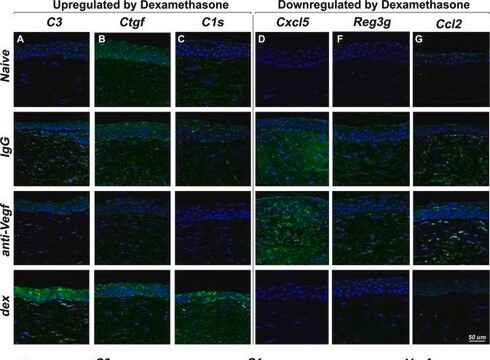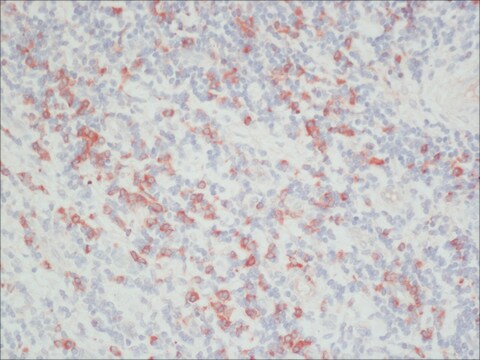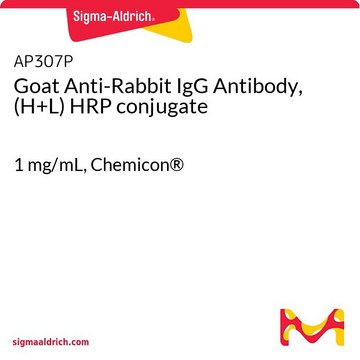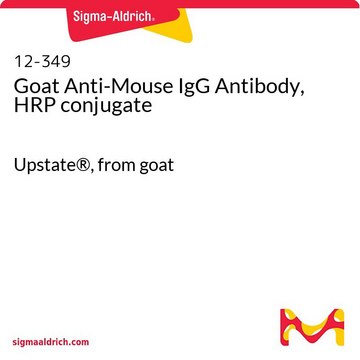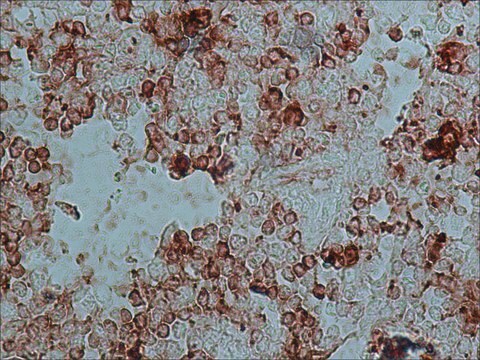AP136P
Goat Anti-Rat IgG Antibody, HRP conjugate
Chemicon®, from goat
Sign Into View Organizational & Contract Pricing
All Photos(1)
About This Item
UNSPSC Code:
12352203
eCl@ss:
32160702
NACRES:
NA.46
Recommended Products
biological source
goat
Quality Level
conjugate
peroxidase conjugate
antibody form
affinity isolated antibody
antibody product type
secondary antibodies
clone
polyclonal
species reactivity
rat
manufacturer/tradename
Chemicon®
technique(s)
ELISA: suitable
immunohistochemistry: suitable
western blot: suitable
isotype
IgG
shipped in
wet ice
target post-translational modification
unmodified
General description
Goat anti-rat IgG affinity purified antibody, HRP conjugated.
Specificity
Specific for rat IgG, heavy and light chain.
Application
Detect Rat IgG using this Goat anti-Rat IgG Antibody, HRP conjugate validated for use in ELISA, IH & WB.
Immunohistochemistry:
1:500-1:5,000 dilution can be used.
Optimal working dilutions must be determined by end user.
1:500-1:5,000 dilution can be used.
Optimal working dilutions must be determined by end user.
Quality
Routinely evaluated on Enzyme-linked Immunosorbent Assay.
ELISA and Western Blots:
1:5,000-1:100,000 dilution can be used..
ELISA and Western Blots:
1:5,000-1:100,000 dilution can be used..
Physical form
Lyophilized. Buffer = 0.01 M Sodium Phosphate, 0.25 M NaCl, pH 7.6 with 15 mg/mL BSA.
Reconstitute with 2 mL of sterile distilled water.
Reconstitute with 2 mL of sterile distilled water.
Storage and Stability
Maintain lyophilized product at 2-8°C for up to 12 months.
After reconstitution the product is stable for several weeks at 2-8°C as an undiluted liquid. For extended storage after reconstitution, add an equal volume of glycerol to make a final concentration of 50% glycerol followed by storage at -20°C in undiluted aliquots for up to 12 months. Please note the concentration of protein (and buffer salts) will decrease to one-half of the original after the addition of glycerol. Avoid repeated freeze/thaw cycles.
WARNING: Use of sodium azide as a preservative will substantially inhibit the enzyme activity of HRP.
After reconstitution the product is stable for several weeks at 2-8°C as an undiluted liquid. For extended storage after reconstitution, add an equal volume of glycerol to make a final concentration of 50% glycerol followed by storage at -20°C in undiluted aliquots for up to 12 months. Please note the concentration of protein (and buffer salts) will decrease to one-half of the original after the addition of glycerol. Avoid repeated freeze/thaw cycles.
WARNING: Use of sodium azide as a preservative will substantially inhibit the enzyme activity of HRP.
Legal Information
CHEMICON is a registered trademark of Merck KGaA, Darmstadt, Germany
Not finding the right product?
Try our Product Selector Tool.
Storage Class Code
13 - Non Combustible Solids
WGK
WGK 3
Flash Point(F)
Not applicable
Flash Point(C)
Not applicable
Certificates of Analysis (COA)
Search for Certificates of Analysis (COA) by entering the products Lot/Batch Number. Lot and Batch Numbers can be found on a product’s label following the words ‘Lot’ or ‘Batch’.
Already Own This Product?
Find documentation for the products that you have recently purchased in the Document Library.
Customers Also Viewed
Audrey Chabrat et al.
Stem cells international, 2019, 2945435-2945435 (2019-06-27)
The discovery of novel drugs for neurodegenerative diseases has been a real challenge over the last decades. The development of patient- and/or disease-specific in vitro models represents a powerful strategy for the development and validation of lead candidates in preclinical
Counteraction of tetherin antiviral activity by two closely related SIVs differing by the presence of a Vpu gene.
Nikovics, K; Dazza, MC; Ekwalanga, M; Mammano, F; Clavel, F; Saragosti, S
Testing null
Intracrystalline proteins and urolithiasis: a comparison of the protein content and ultrastructure of urinary calcium oxalate monohydrate and dihydrate crystals.
Rosemary L Ryall,Magali C Chauvet,Phulwinder K Grover
BJU International null
Hiba El Hajj et al.
PloS one, 8(11), e79474-e79474 (2013-11-20)
Kaposi sarcoma-associated herpesvirus (KSHV) is the etiologic agent of primary effusion lymphomas (PEL). PEL cell lines infected with KSHV, but negative for Epstein-Barr virus have a tumorigenic potential in non-obese diabetic/severe combined immunodeficient mice and result in efficient engraftment and
Jun Zhang et al.
Nature communications, 12(1), 4380-4380 (2021-07-21)
Recognition and fusion between gametes during fertilization is an ancient process. Protein HAP2, recognized as the primordial eukaryotic gamete fusogen, is a structural homolog of viral class II fusion proteins. The mechanisms that regulate HAP2 function, and whether virus-fusion-like conformational
Our team of scientists has experience in all areas of research including Life Science, Material Science, Chemical Synthesis, Chromatography, Analytical and many others.
Contact Technical Service



